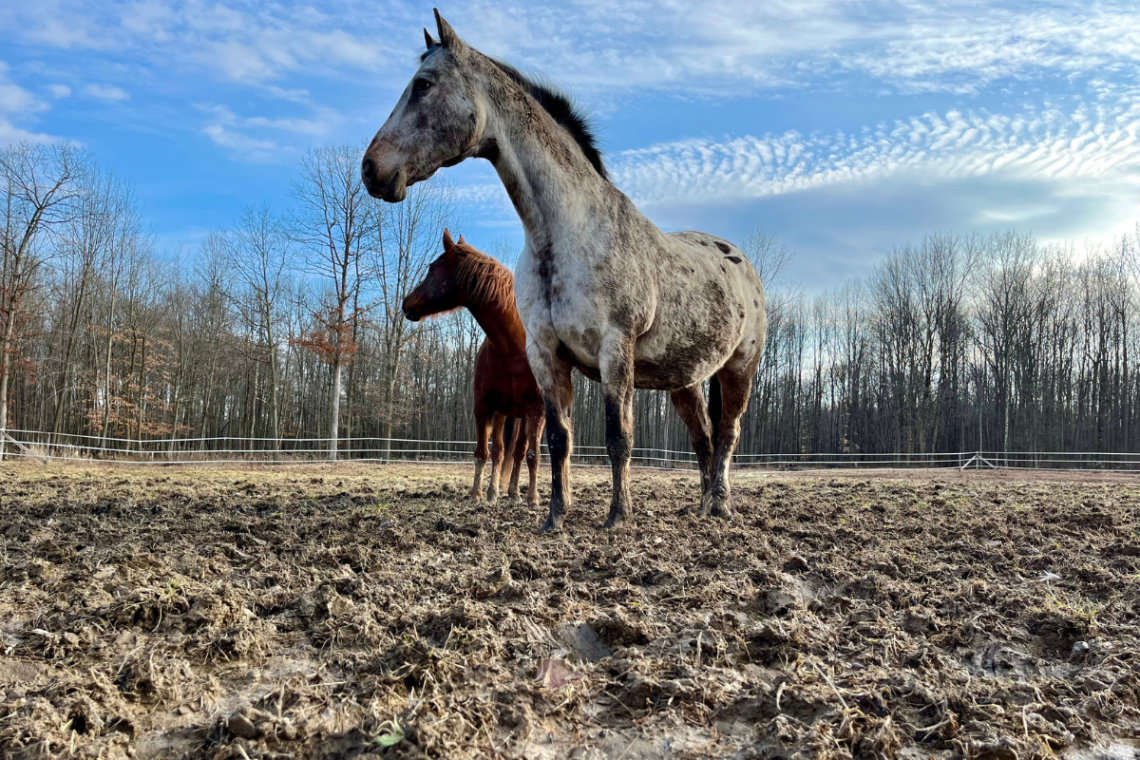Whether you have horses, goats, ducks, or chickens, mud is going to become a headache on your farm several times per year, depending on your climate. While some amount of mud is inevitable, there are a few things you can do to alleviate much of the mud and muck, both right now and long-term.
Here are a few of the temporary and long-term tricks I’ve found to help manage mud around the farm for better footing for both you and your animals.
1. Use Alternate Entrances If Possible
A little planning can go a long way before the mud hits. If your setup allows for multiple pathways in and out of the barn or pastures, plan to alternate these entrances to cut down on the mud. For example, my barn has two large sliding doors. I keep one closed for most of the year so that both entrances aren’t mud pits by spring. Then, when the main entrance is too slick to use comfortably, I have a dry, grass-filled alternate route. If you are able to similarly redirect traffic into paddocks and pastures, you can limit the wear and tear to those entrances come mud season.
2. Use Shavings or Chaff on High-Traffic Areas
If you are in the thick of mud season and need a temporary solution right now, spreading wood shavings or hay chaff on high-traffic areas can do the trick. These organic materials will decompose, so this won’t be a long-term solution, but it can work wonders in a pinch.
While I’ve heard others suggest putting gravel down, I don’t recommend this as a temporary solution. Once you spread gravel, it’s there permanently. Some horses can have trouble walking on gravel, and you don’t want to find out yours is one of them after you’ve already spread it in front of the only barn entrance. Additionally, you don’t want to spread gravel in areas where grass will grow in the spring and you’ll need to mow over. If you are going to use gravel on the fly, go with pea gravel.
3. Reroute Runoff
Pay attention to where water is running from gutter systems and natural runoff routes. Dig shallow trenches or use pipes to redirect that runoff away from high-traffic areas and dry lots. For around $200, we used PVC pipe to reroute our arena’s gutter system 60 feet in the opposite direction so it didn’t dump directly into the corner of the pasture. This was well worth the small investment! We’ve also worked to reroute the natural runoff on the property so it doesn’t collect in the pastures.
4. Strategically Place Snow Piles
In the middle of winter, the most convenient way to remove snow around gates and barn doors is to move the snow as little as possible. But this can create huge mud problems once the snow melts. Create a plan to place snow piles out of the way of high-traffic areas, ideally in an elevated spot.
5. Create a Dry Lot
A dry lot or “sacrifice paddock” is a well-drained fenced area that doesn’t have any grass or other vegetation. To ensure it is well-drained, you can invest in special mud control mats or use a system of sand and gravel for drainage. Ideally, your dry lot is situated in an elevated area that allows water to drain away from it.
Not only is a dry lot great to have available for horses who need to be on limited grass intake or who have summer allergies, but it is also a vital tool to manage mud. While creating one is more of a long-term solution than a quick fix, it is never too early to start planning its design for next year’s muddy season.
6. Promote Healthy Root Systems
The best way to minimize mud and ensure healthy, sustainable pastures well into the future is to take steps to promote healthy root systems. Creating a dry lot is one way to do this, as keeping your animals off of muddy pastures will help to maintain the integrity of the root systems and soil structure in your main grazing areas. Avoid overgrazing these areas at all costs, as that will quickly compromise root structures and will contribute to mud and poor soil conditions.
You can also strategically plant trees, shrubs or other vegetation in areas prone to mud. Just make sure they are safe for horses or other animals that will have access to them.
Bottom Line
Mud is an inevitable hurdle when keeping animals or growing crops, but it doesn’t have to halt day-to-day life on your homestead or farm. While temporary fixes can work in a pinch, it’s best to plan some long-term strategies to help prevent excessive mud in key areas of your property in the future.
Do you have other tips and tricks for dealing with mud? Leave them in the comments!






